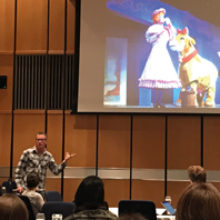Teaching Microbiology in Higher Education Symposium satellite meeting
Issue: Microbes and Food
07 August 2018 article

The Microbiology Society held its first Teaching Microbiology in Higher Education Symposium as a satellite meeting before the Annual Conference 2018. We were delighted that the event, a result of our members asking for more support for teaching-active individuals, was a great success, bringing delegates together to discuss and share teaching practices and starting a network of microbiology lecturers.
The symposium began with a poster session over lunch, to create a space for the exchange of ideas and to start an interactive day where knowledge flowed between delegates. Posters were also available during the Annual Conference.
As the ever-changing landscape of teaching is affected by many factors, including the Teaching Education Framework, Dr Tadhg Ó Cróinín, Chair of the Society’s Professional Development Committee which organised the symposium, began the day in conversation with Rachel Lambert-Forsyth, Royal Society of Biology, and Professor Jeremy Pritchard, University of Birmingham. The discussion ranged from topics such as the future of university teaching, to the way pedagogy is taught in various courses.
New teaching methods often involve finding inventive ways to engage students. During the first session (Using digital platforms for teaching in higher education), Dr Helen Gadegaard, University of Glasgow, explained how Labster, a virtual lab simulator, can teach students just as well as conventional wet-lab sessions, showing the cost efficiency of using online teaching resources for large groups.
Dr Stephen McClean, Ulster University, demonstrated his use of the interactive cloud-based audience response tool, Nearpod, exploiting gamification to help students benefit from peer interaction. Dr Alison Graham, Newcastle University, showed how she involved undergraduate students in the assessment process using the electronic platform Grademark, with the aim of improving the clarity of marking criteria, leading to the creation of a library of feedback comments to improve marker consistency. Discussion on how to engage students who do not look at their feedback, showed that this remains a challenge for many lecturers.
In the cases presented, digital platforms have enabled better access to, and engagement with, large groups of students as well as better use of time spent teaching.
Dr Ian Turner, University of Derby, began the Novel Techniques in the Lecture Theatre session with his unique approach to lectures: using pantomime. He described a creative and interactive method for enabling students to understand the fundamental elements of biology. By using props for visual representation, a mental association was created and students learned basic interactions.
As well as invited speakers, the symposium allowed delegates to present their work as posters and we also heard insightful offered oral presentations. Talks on a flipped classroom approach, the use of role-play-based workshops, and cultivating student creative self-efficacy all stimulated conversation and allowed delegates to consider alternative approaches to their current teaching methods.
The success of the Society’s first Teaching Microbiology in Higher Education Symposium would not be without fantastic contributors, so we would like to thank our invited speakers, offered oral and poster presenters. The exchange of knowledge was invaluable; so much so that we are delighted to announce that the second Teaching Symposium will take place in 2019.
Rachel Asiedu
Professional Development Officer
[email protected]
Further information: This article states the Microbiology Society held its first Teaching Microbiology in Higher Education Symposium as a satellite meeting before the Annual Conference 2018. This is in reference to the event being a satellite of the Society’s Annual Conference, which was established in 2014. To find out more about previous teaching-focused activities please see past issues of Microbiology Today or the education and outreach section of the website.
